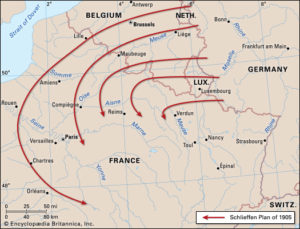1914
Germany invades France
After a month of posturing and threats following the assassination of the heir to the Austrian throne, the powers of Europe finally take up arms; with the German invasion of France the Great War, the First World War begins.
The German General Staff had long planned their strategy for the conquest of France. Knowing that they faced enemies on two fronts — the French Republic to the west, the Russian Empire to the east — they counted on a quick strike to knock one of their enemies out of the war before turning to confront the other. Since France was more highly industrialized and mechanized, they could mobilize their armies more quickly than the Russians, so the Germans made the French their first target. According to the Schlieffen Plan, proposed in 1905 by Field Marshal Alfred von Schlieffen, the Chief of the Imperial Army German General Staff, the German army would concentrate its forces on the Western Front and avoid French fortifications by invading through neutral Belgium and Luxembourg, a gross violation of international law and a treaty to which Germany was a signatory.
On August 3, seven German field armies, comprising 80% of the empire’s armed forces, began to move, sweeping through Belgium and Luxembourg, hoping to smash the French armies on the border and encircle Paris. At first they were successful, taking the great fortress of Liege and capturing Brussels. The French, meanwhile, were concentrating on a thrust east into Alsace, held by the Germans since the Franco-Prussian War of 1870 but considered by the French to be theirs. By late August German forces had entered France, coming to within 43 miles of Paris, where they were stalled by stiffening French resistance and the arrival of the British Expeditionary Force. The Schlieffen Plan had failed; the result was a stalemate and four years of hideous, near-static trench warfare.
